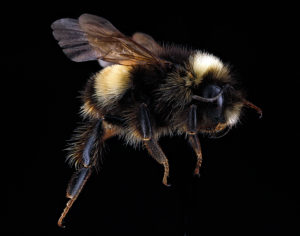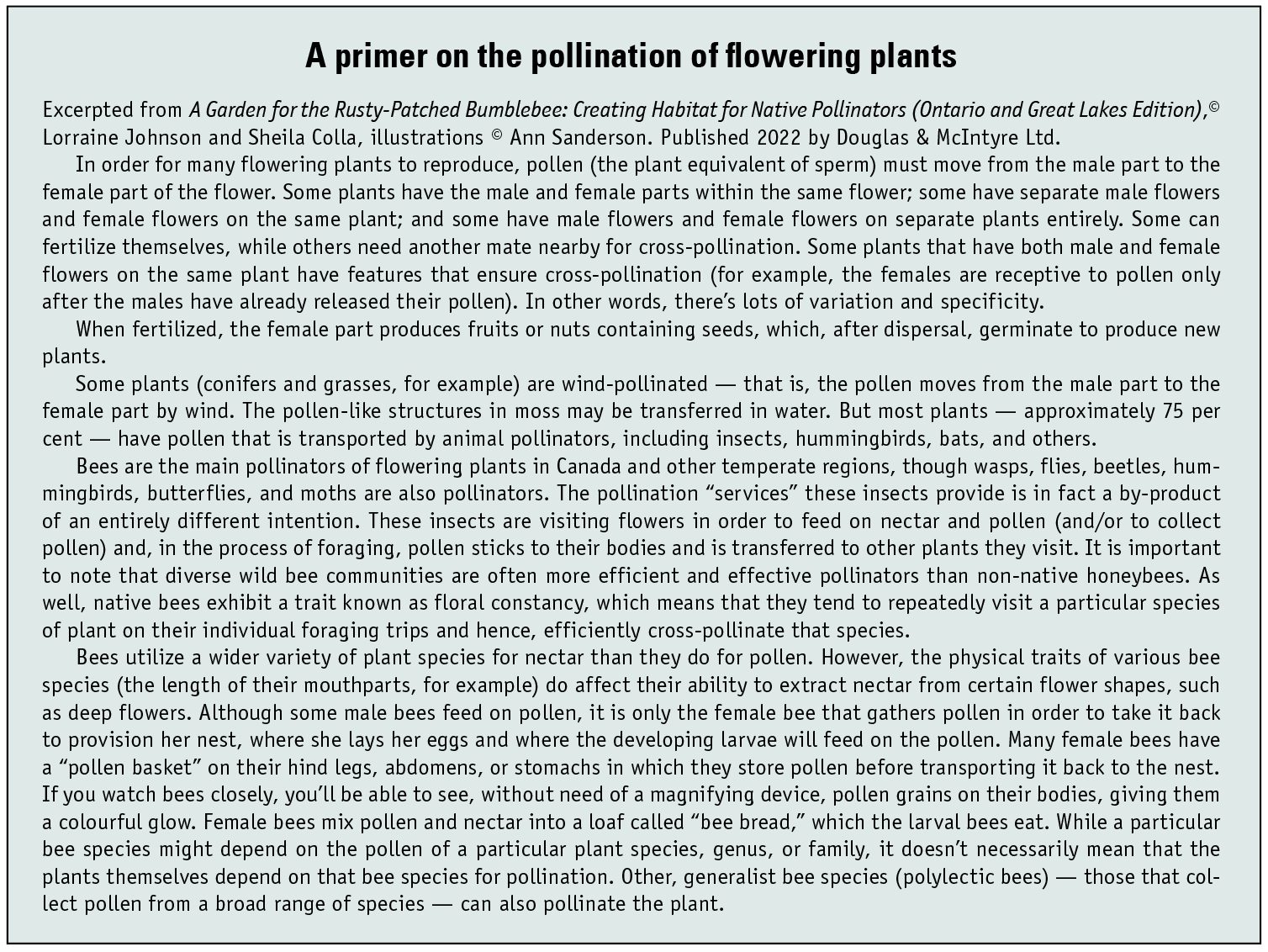The Lives of Wild Native Bees – FREE ARTICLE

Caption: Bombus terricola
Credit: United States Geological Survey
To view the photo-rich magazine version, click here.
Originally appears in the Summer 2022 issue.
By Bea Olivastri and Caitlin McCloskey

In some cases, the use of pesticides has reduced or obliterated wild native bees and people must hand-pollinate plants. The classic example is in China. UK Professor Dave Goulson (https://profiles.sussex.ac.uk/p126217-dave-goulson) describes the situation:
Evidence from around the world points to falling and increasingly unpredictable yields of insect-pollinated crops, particularly in the areas with the most intensive farming. Where crops are grown in vast fields, there are not enough insects to go around. If insecticides are sprayed too frequently, then vital pollinators cannot survive.
The most dramatic example comes from the apple and pear orchards of southwest China, where wild bees have been eradicated by excessive pesticide use and a lack of natural habitat.
In recent years, farmers have been forced to hand-pollinate their trees, carrying pots of pollen and paintbrushes with which to individually pollinate every flower, and using their children to climb up to the highest blossoms. This is clearly just possible for this high-value crop, but there are not enough humans in the world to pollinate all of our crops by hand. (Reference: https://chinadialogue.net/en/food/5193-decline-of-bees-forces-china-s-apple-farmers-to-pollinate-by-hand/)
Some terminology for bee behaviour
Bees feed on nectar and pollen or collect it and, while doing so, they also transfer pollen. Pollination, then, is usually the unintended byproduct of a bee’s foraging activity. Foraging is the behaviour that bees engage in when they are collecting food. Bees feed on pollen from a flower for protein and fats, and nectar for carbohydrates and nutrients. Just like humans need a balanced diet, so do bees. As they fly from flower to flower collecting pollen and sipping on nectar, pollen grains stick to a bee’s fuzzy legs or body. When a bee visits the next flower, some of that pollen gets shaken off and lands on that new flower. This is how cross pollination occurs.
Bees and flowers share a symbiotic relationship. The flowers feed the bees, and the bees pollinate the flowers. Both organisms rely on the other for their survival. While all bees feed on plants for pollen, nectar, or both, different bee species vary widely in their dietary habits. Some bees are generalists, meaning that they visit many different types of plants, and some are specialists, meaning that they might feed only on one specific plant, or a family of plants.
The types of plants that bees require for foraging are referred to as floral resources. It’s very important for bees to have access to abundant floral resources within close proximity to their nesting site. While some larger bees (like honey bees or bumble bees) can travel many kilometres in search of food, other wild bees have much shorter foraging ranges (the distance from the nest that a bee is able to travel while foraging). The Squash bee, for example, is a dietary specialist of Cucurbita flowers (pumpkin, squash, zucchini, and Wild buffalo gourd). Squash bees are thought to have very short foraging ranges, so it is imperative to their survival that their nests are close to the plants they depend on.
Even plants that self-pollinate benefit from the presence of bees, as wild bee pollination has been shown to increase the yield of many fruit-bearing plants. (Reference: https://www.science.org/doi/abs/10.1126/science.1230200)
Where and how do wild bees live? (Bee nesting and sociality)
“Guilds” are a way of categorizing wild bee nesting behaviour. Approximately 70% of wild native bees are ground nesting, which means that they burrow tunnels in soil to create their nests. Different species have different preferences for soil type, ranging from loose and sandy soil to hard-packed earth. The size and shape of ground nests differ among bee species.
The remaining 30% of bees nest above ground, in pre-existing cavities in dead trees, pithy plants stems, or any other types of cavities (some species even use abandoned snail shells).
Some cavity-nesting bees excavate their own cavities in standing wood with their powerful mandibles. Others, such as bumble bees (Bombus) using pre-existing cavities such as rodent holes. Finally, some bees are cleptoparasitic, meaning they do not construct their own nests but instead lay eggs in active nests of other species
Scientists know very little about nesting sites and the way ground-nesting bees can be impacted from a wide range of activities, including the use of tillage in agricultural systems that can destroy shallow nests. The use of pesticides to combat insect pests can also affect wild bees by reducing the number of nests they build, the amount of pollen they harvest, and the number of offspring they produce. Other farming practices such as cover crops, plastic cover, or straw on the soil surface may have consequences for ground-nesting bees and need more research. Scientists are calling for more research to understand how to support ground-nesting bees and the vital services they provide. (Reference: Nesting habitat of ground-nesting bees: a review https://resjournals.onlinelibrary.wiley.com/doi/full/10.1111/een.12986)
Nesting guilds
Solitary ground nesters – These bees dig holes in the ground for nests and live on their own (examples include Colletes, Andrena, Agapostemon, Lasioglossum subgenus Lasioglossum, Lasioglossum, and Eucera). Males do not usually help with nest building or providing provisions for larvae.
Social ground nesters – These typically have one reproductive female per nest and many other females that help with nest building and foraging. They are generally active for only a few weeks. These bees prefer open habitat, especially dry, sandy soil (Lasioglossum subgenus Evylaeus, Augochlorella, Halictus).
Cavity-nesting (or above-ground nesting) – These bees are often solitary and nest in pithy plant stems, rock cavities, and abandoned beetle burrows in wood and usually find a pre-existing cavity (Hylaeus, Augochlora, L. (D.) cressonii Robertson, L. (D.) semicaeruleum Cockerell, Hoplitis, Osmia, Ceratina).
Carpenter bees – These bees can live communally with several reproductive females sharing a nest. They excavate tunnels in wood, often in wood structures but also in woody plants or raspberry canes.
Bombus spp. – Bumble bees have their own guild because they are social (not solitary) cavity nesters with colonies which can have many individuals per nest and activity over a long period, typically from spring through to the fall. They can nest below ground or above ground, depending on the species.
Cleptoparasitic – They do not construct their own nests but instead lay eggs in active nests of other species. These bees are known as Cuckoo bees and are part of the Apidae and Halictidae families.
Sociality
Bee species also differ from one another in terms of sociality. The vast majority of native bees in North America are solitary, meaning that once the female mates, she builds her nest and provides for her offspring alone.
Some solitary bees nest in aggregations, in which each bee builds and maintains their own nest, but in close proximity to other bee nests. Aggregations typically occur among ground-nesting bees and can contain hundreds or even thousands of nests.
Other species of solitary bees nest communally, in which several bees share the same entrance to a nest, but create separate nests once inside. This is like the bee equivalent of an apartment building, in which more than 40 bees might share an entrance but have their own nest and egg cells.
Some bees are semi-social, behaving very similarly to social bees like honey bees who live in a colony. The key difference is that semi-social nests are generally much smaller, less complex, and the semi-social nest lasts for just one generation.
Most people will be familiar with eusocial bees, like honey bees and bumble bees. Eusocial bees live in a colony where provisioning and caring for offspring duties are shared. A eusocial colony consists of a queen, her daughters, and drones (males). Honeybee colonies are made up of tens of thousands of bees, may last many generations, and are capable of complex communication. Bumble bee colonies are much smaller and only a new queen survives through the winter to re-establish the colony.





